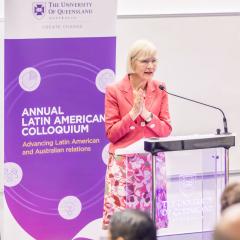Co-management of coastal resources has the potential to enhance the capacity of communities and governments to adapt to environmental change.
Overexploitation of natural resources, biodiversity loss and climate change are just some of the environmental challenges the world faces today. In order to respond to these challenges, societies need to create and nurture conditions that are conducive to enhancing the capacity of individuals, groups and organisations to adapt to them. Co-management, as opposed to more than traditional forms of regulatory management, is believed to be an effective approach for enhancing adaptive capacity.
Coastal resources are at risk – could co-management help?
Beginning in 2014, an international research team led by UQ researcher Dr Pedro Fidelman engaged with community groups, resource users and governments involved with co-management of coastal resources in Cambodia and Vietnam, with the aim of understanding the conditions that enable adaptive capacity.
“Co-management involves collaboration and shared responsibility between state and non-state actors; for example, between government authorities and resource users,” said Dr Fidelman.
The project focused on the Peam Krasaop Wildlife Sanctuary in Cambodia, and Tam Giang Lagoon in Viet Nam, where a co-management approach was adopted in the 1990s as a response to the decline of coastal resources.
Drawing on interviews and focus groups with relevant community members, resource users and government authorities, the co-management arrangements in Peam Krasaop and Tam Giang were assessed against key attributes of adaptive capacity.
The key attributes are the variety of participating social and political actors and the diversity of the actions and issues addressed; learning capacity based on activities that involved learning (e.g. meetings and decision-making); autonomy, or the authority to make and implement decisions that are not undermined by other decision-making entities; leadership; resources, including human, financial and technical resources; and fair governance.
Co-management can enhance adaptive capacity, but it’s a balancing act
“In both the Peam Krasaop Wildlife Sanctuary and Tam Giang Lagoon, co-management enabled the six attributes of adaptive capacity to varying extents,” Dr Pedro Fidelman said.
“The enabling and disabling conditions are interdependent, and they can reinforce and/or undermine each other.”
External financial and technical resources were critical to support learning activities. These learning activities aimed to allow a variety of villagers, fishermen, government authorities and technical staff to participate in co-management. And the resources helped mobilise leadership by reducing the costs of participation. Leadership, in turn, was critical to mobilising the external technical resources and to demonstrate authority and autonomy. Policies and legislation provided legitimacy and legal authority for local actors to take part in coastal resource management, supporting governance and variety of participants.
However, it was also evident that limited resources and autonomy constrained the leadership qualities of local actors, and governance, in the form of inconsistent policy implementation and law enforcement, undermined local authority in some instances.
Local level successes are within reach
Despite the potential disabling factors at play, researchers determined that co-management was an effective approach to enhancing adaptive capacity, particularly at the local level.
“Co-management has enabled actors to organise themselves; to learn and improve resource management; to mobilise leadership, resources and authority; and to make progress towards improved governance,” Dr Fidelman said.
“But power imbalances and conflicting interests among the actors are important challenges to implementing co-management – challenges that may lead to maladaptation rather than adaptation.”
Enhancing adaptive capacity in the Peam Krasaop Wildlife Sanctuary and Tam Giang Lagoon will require strategies to reinforce existing enabling conditions, such as securing adequate levels of financial and technical resources, supporting local decision-making authority, developing conflict resolution mechanisms, providing alternative livelihoods, alleviating poverty, reducing inequality, and building human and social capital.
Research funding
Asia-Pacific Network for Global Change Research (APN)
Partnerships
This project involved partners from the Hue University of Agriculture and Forestry (Vietnam) and the Ministry of the Environment (Cambodia).



